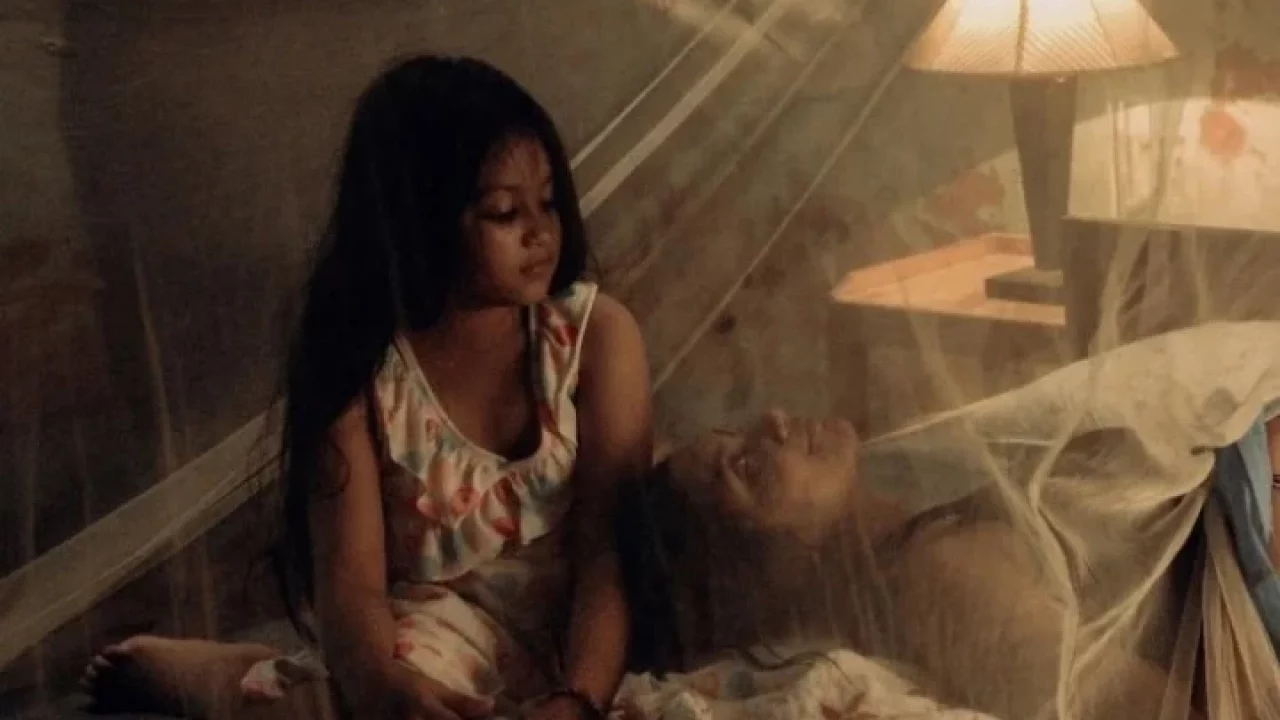The horror genre in films made in the Bengali language has been left unexplored in recent times. Although some horror films were made, their quality has been underwhelming, and seldom do they have the credibility to be recognized in public. While the Bengali film industry in India has been disappointing in delivering good horror movies, films made in Bangladesh, on the other hand, have been experimenting with several subjects and genres. ‘Moshari’ (Mosquito Net, 2022) by Nuhash Humayun is one such work from Bangladesh that deserves more recognition and acknowledgment than it has received so far. It’s much more than a typical horror fare as it commentates on several sub-texts and delves into thought-provoking concepts that one might feel untapped in Bengali language films.
Horror films are often made of traditional tropes: supernatural elements, use of myths, and superstitions are married with mystery and darkness. To deliver these aspects with enough believability and conviction, a strong expertise in the technical aspects, especially in light and sound, is required. ‘Moshari’ surpasses in all these sectors. It offers the viewers a perfect amount of suspense and mystery with some impeccable staging techniques. But this article will not focus much on the technical prowess that the film possesses. It will mainly deal with the themes hidden underneath and the subtexts that can be deciphered. Because ‘Moshari’ is a film that transcends the commonality of the horror genre that very few movies do.
Nuhash Humayun’s ‘Moshari’ is a 22-minute award-winning horror short film that stars Sunerah Binte Kamal and Nairah Onara Saif and is produced by Little Big films with distribution done by Jordan Peele’s MonkeyPaw production. The film shows a dystopian world where Sunerah and Nairah, as two sisters, make their way out for survival. It projects an apocalyptic world that witnesses the near extinction of humanity because of the rising threat of monsters.
From the opening scene of a dead cow, it becomes clear of the eventual slaughterhouse that these monsters have transformed the world into. Thus, the only way of surviving and protecting oneself is by being inside a mosquito net at the very onset of dusk. Like a net that is used to prevent mosquitoes from biting and spreading diseases, the net here is also used as a protective shield against the monsters.
There are scenes where viewers can see multiple nets being set up one after the other by the surviving people as Sunerah and Nairah walk past them. At the same time, an announcement continues in the background, insisting people to be inside the net till the morning. The report also divulges one significant fact- no faith in any religion or symbol can save people’s lives or terminate this catastrophe. Of the sisters, the elder sister, played by Sunerah (referred to as Apu- not a name but means sister), is very much aware of the present scenario and is highly protective of her younger sister, Ayra.
Though Ayra seems quite accustomed to the threatening environment, she tends to break through the obligations to reclaim her ‘space’ and experience a bit of freedom. Both the sisters share a very close bond with each other. The threat of existence has forced them to succumb under the restraints of a net to protect themselves at all costs, thereby enforcing a claustrophobic atmosphere upon themselves.
Humayun, here, has introduced certain interesting aspects that eventually talk about the dark realities of the present society. Decoding ‘Moshari,’ one might gather contradictory yet interlinked notions. The first thought one might come across is the apparent suppressive environment experienced by women in the present society. Though the net protects the remaining of humankind, it serves as a special shield specifically for women threatened by ‘evil’ men. It clearly hints at women’s extreme physical and mental subjugation because of the hostile, unsafe environment propagated by men. Humayun, at a particular moment in the film, uses very significant lines that further denote these thoughts:
“They are just like old men. They like it young”.
Here, ‘they’ have been primarily referred to as the vampires who have caused this dysfunctional apocalyptic world, but it also denotes the monstrosity of old men holding power over women. The elder sister says that monsters, synonymous with ‘old men,’ like to prey on young girls- denoting the cruel world they live in, where young, innocent girls are the most unsafe. Ayra, in the film, repeats particular lines multiple times:
“I can’t breathe”.
“This is my space. You can’t come in”.

These are clear indicators of the sisters’ thwarted livelihoods that prevent them from experiencing liberty and independence. Ayra, in this frustrating social milieu, often performs as the sole individual to regain her much deserving ‘space’; she attempts to break free from the limitations- the shield, which is protecting her life and curtailing her freedom at the same time. Nuhash also incorporated certain close-up scenes of the elder sister’s nail getting broken while tying up the net and also pieces of glass piercing through her foot, symbolically denoting how ruthless and violent the surrounding is and the amount of pain and suffering women have to endure.
Both the sisters are trying to perceive the world through their own perspectives. On one side, Ayra remains a living symbol of innocence owing to her young tender age. On the other hand, her elder sister is quite adept with the scary environment. She tries to safeguard her sister with her experience and instructs her repeatedly to be inside the net. It is also understandable that their mother had become a victim of these monsters, as Ayra often says –
“If Mom were here, she’d play with my hair like this.”
This monstrosity ultimately has snatched away the presence of a mother figure, a symbol of guidance, shelter, and security, from their lives. Both of them await the following day for a new ray of hope when they might regain some control. They are in constant search for light while living amidst darkness that only acts as a harbinger of impending violence and death.
The other thought that came to my mind while watching ‘Moshari’ is something that might be controversial and argumentative. While the film has been brilliant in highlighting women’s subjugation, Nuhash Humayun has also subtly explored the concept of ‘reverse colonization.’ This concept might be unknown to some or known yet debatable to others, but it would be best to create a ‘dialogue’ through discussions because Moshari deserves that. ‘Reverse colonialism’ breaks out from the common idea of colonialism. This aspect was explored well in Bram Stoker’s ‘Dracula’ (1897), where we could see Dracula, the Transylvania vampire, slowly invading England to spread his terror, invading modern civilization.
Because of his arrival, the city dwellers who have embraced modernity and are termed well-mannered, in general, subsequently became trapped in their own city. They fear contamination of their privileged, civilized race with that of an allegedly inferior race (which apparently does not promote any virtues of a civilized human being because they have parasitic bloodlust) that may result in ‘racial pollution.’ In reality, under the pretense of spreading civilization, Empires have often expanded their kingdom/territory, undermining the freedom of the natives and exploiting them.
The role reversal happens in the novel, where we see an outsider intruding and disturbing the order and decorum of a modern society by spreading terror. Dracula, a representative of the peripheral region like Transylvania in Romania, which is outside the mainland of civilization and modernity, invades and captures the city. He projects the fear of ‘racial pollution’ with the rapid spread of vampirism, resulting in an apparent plague in the society. Characters in the city feel helpless and suppressed, striving for survival with the aim of diminishing this overpowering domination of the vampire.
‘Moshari,’ too, refers to this notion of invasion literature. At the beginning of the film, as mentioned before, announcements were being made in the background, saying:
“Europe and America have fallen ill. Western countries that mock our poverty called us third-world country, sucked our blood, they are gone.”
It clearly indicates that the rapid rise of these monsters and their violence have encapsulated the Western civilization, which proudly considered itself superior. Therefore, the once ‘indomitable’ has now been ‘dominated’ and subdued. The fear of violence and death captured the first-world countries; they have fallen prey to this atrocity. No amount of development they advocated has been sufficient in controlling or evading this life-threatening situation. Yet, it is a so-called third-world country like Bangladesh and a city like Dhaka, which is still surviving, albeit slowly dissolving. In a way, the entire civilization is engulfed by the myth of monsters; humankind is surrendering to the conquest of the vampires. The human tendency to colonize, capture, overpower, and dominate is being thwarted and disabled by the rise of a new set of beings originating in the myth far from our notions of civilization.
Eventually, ‘Moshari’ knowingly or unknowingly commentates on the monstrosity of human vices that have captured and ‘colonized’ human consciousness. Despite advancing rapidly through technology and innovations, the modern world has witnessed several instances of human suffering, be it through war, poverty, famine, epidemic, or environmental hazards. History provides concrete proof regarding recurrent occurrences of these threatening societal issues, which have not confined themselves to one state or a country but have periodically occurred worldwide. The root cause of all these issues rests on human ignorance, negligence, and wrongdoing. ‘Moshari,’ therefore, shows a manufactured dystopian world where monsters portray human immorality and wretchedness. In contrast, survivors like Ayra and her elder sister are representatives of human virtues: expressing bonding, care, and affection for each other.
To conclude, ‘Moshari’ will remain one of the best horror films in recent times. It successfully triggers questions on varied themes and contexts. I must admit that this article is not enough to justify this film’s magnificence. As I said at the beginning of my write-up, the arguments put forward might be controversial and surely would invite debates and discussions. And ‘Moshari,’ deservingly, should be included in discussions. In this way, a film becomes truly successful regardless of its duration.



![The Brand New Testament [2015]: “Divine Intervention”](https://79468c92.delivery.rocketcdn.me/wp-content/uploads/2016/03/The-Brand-New-Testament-3-768x467.jpg)


